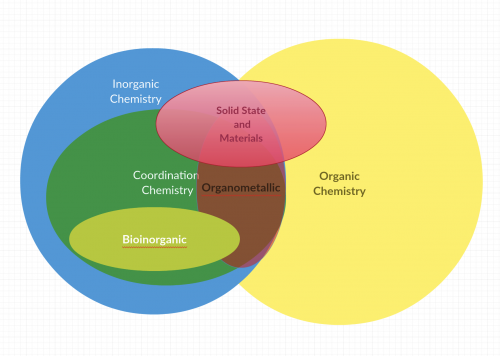
This Venn Diagram came to being sort of (In-)organically on the first day of my sophomore level intro to inorganic course. As I always do, I started the course with the IC Top 10 First Day Activity. (https://www.ionicviper.org/classactivity/ic-top-10-first-day-activity). One of the pieces of that in-class-activity asks students- novices at Inorganic Chemistry- to sort the articles on a current list of the Most Read Articles from Inorganic Chemistry into bins of the various subdisciplines of Inorganic Chemistry based only on the title of the article. The point of that exercise is to introduce students to the breadth of the field, while acknowledging the silos and overlaps that exist inside it. As the discussion unfolded, I just sort of started spontaneously drawing a Venn Diagram on the board, because what bettter way to talk about sets and subsets.
The Venn diagram above sort of evolved several times; much erasure and redrawing was done in real time as the in-class discussion with students proceeded. After class, I sent a snapshot to my Inorganic colleagues on the IONiC/VIPEr Leadership Council. We edited some, added pieces and ultimately made the decision together to pull analytical and physical outside of the circles.
It's possible that you think the resulting Venn diagram is not correct. It's possible that you're right. Maybe I left things out that you think should be there. Maybe you think my overlaps are wrong. The Venn Diagram will probably never be perfect. Maybe that's not the point.
"Inorganic Chemistry" encompasses such a broad array of topics. That's among the fundamental reasons why VIPEr exists. We get one, two if we're very lucky, semesters to teach our students the chemistry of the entire periodic table, in all manner of applications. It’s important to me that my students understand that it's not just "dead stuff", OR things that have NO Carbon, OR transition metals...OR... OR ...OR.... To me, (and I admit I'm a bit biased), Inorganic Chemistry is all about the "AND".
In my own evolution as an inorganic chemist, I have been a practicing coordination chemist AND a laserjock (Ru-polypyridals and DNA). I have been a practicing analytical chemist AND a biochemist AND a pharmaceutical chemist (Electrocatalysis of FeNO complexes). I have been a protein chemist AND a molecular biologist AND a PChemist (purification of FeS- proteins). I have been a practicing biophysical chemist (EPR of copper and iron containing proteins). These days I think of myself as a biophysical/bioanalytical/bioinorganic chemist AND an educator… AND a chicken wrangler (long story...really long...TL;DR).
It’s my opinion that Inorganic Chemistry has all the best problems, and all the best opportunities to learn new skills AND to apply old skills to a new problem. My teacher hat lets me share this opinion with students year after year. VIPEr helps me to stay on top of the areas that are not my own so that I don’t inappropriately narrow my students’ field of view by teaching only those topics I am most comfortable/confident with.
When I need to teach a lecture on electron counting in organometallic complexes or unit structures of crystalline solids, I troll the site for a little help from my friends. In fact, this is one of the most common benefits our community members cite in communtiy survey data. So next time you're feeling a bit trepidacious about that lecture on a topic you haven't thought of since your own undergraduate days,...

Thanks Sheila for the great idea! I also agree with your advice to search the site for ideas to get help. Most of my really good ideas start with a VIPEr search...
I feel fortunate to have VIPEr as a resource ... many a LO is a good starting point !